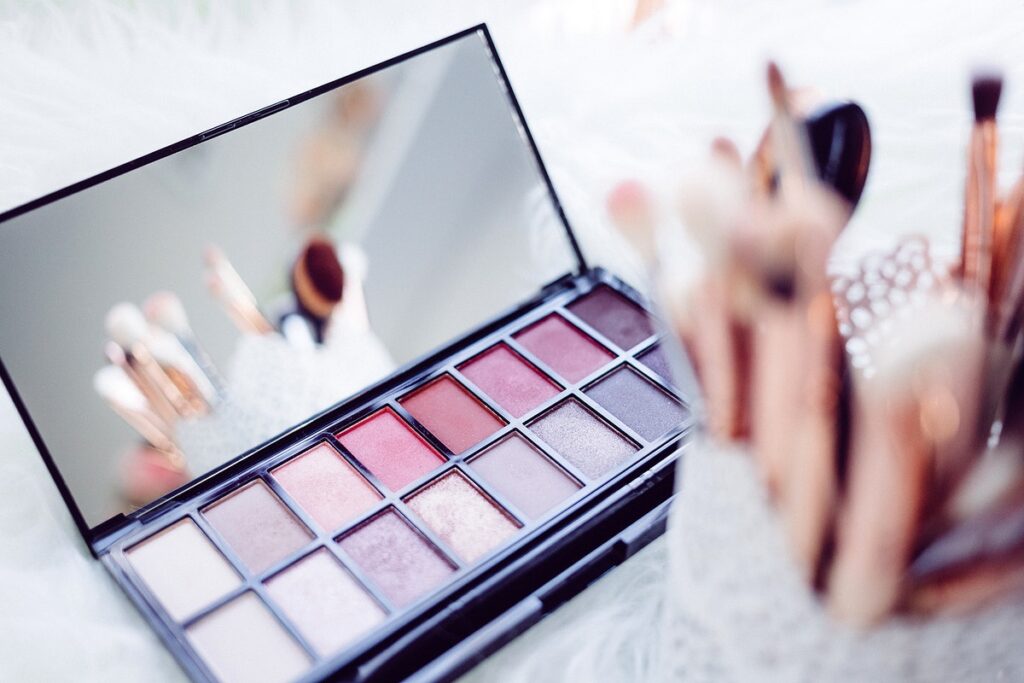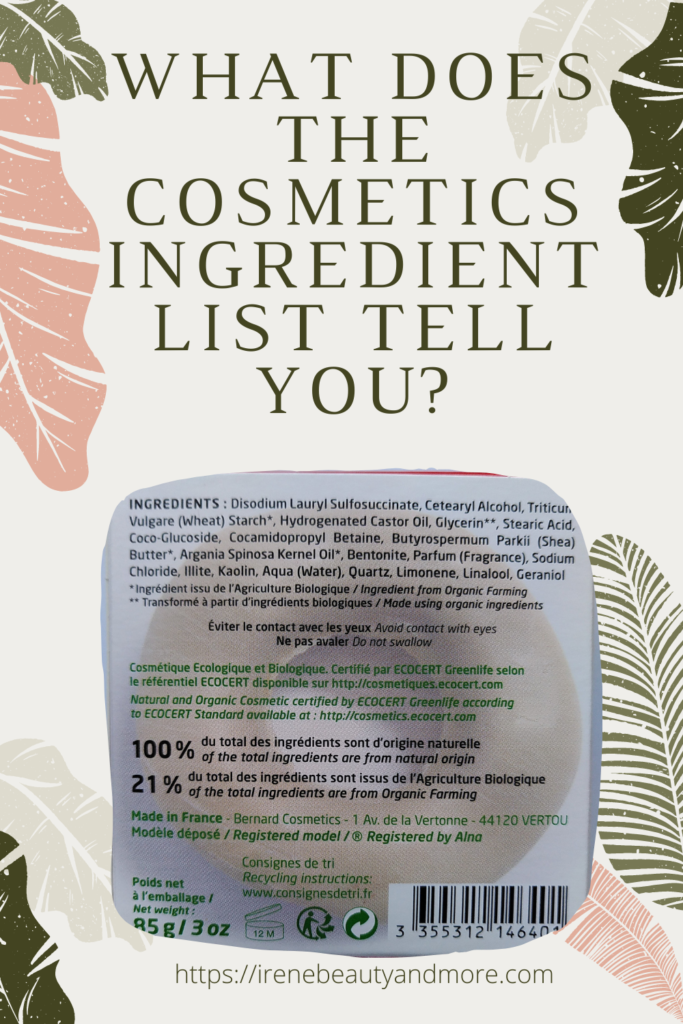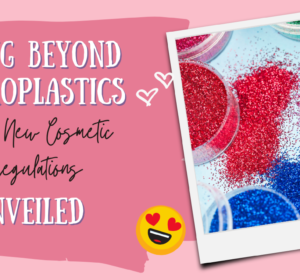It is very common when we talk about cosmetics to mention the INCI. We all have heard things as “a cosmetic should display the INCI” or “certain ingredient is in the first position in the INCI”. However, when we say that, we are referring to the cosmetics ingredient list, which is not the same as the INCI.
What is the INCI? What is the difference between INCI and the ingredient list? Which information can we take from the ingredient list? I am going to answer all these questions in this post.

What is the INCI?
INCI is the acronym of International Nomenclature of Cosmetic Ingredients. It is a list of standardized names for the ingredients used in cosmetics published by the Personal Care Products Council.
The idea is that people from any part of the world can read and understand the ingredients contained in a product, independent of where it is made. That is very important, mainly in the case of allergies to some ingredients.
The ingredient list, however, is the list of all the ingredients used to prepare the cosmetic. The ingredients displayed in the ingredient list must follow the INCI guidance and must appear on the cosmetic label.
Basic rules cosmetics ingredient list should follow
The order of the ingredient in the ingredient list is not random. There are rules about the order in which the ingredients should appear in the list. These rules are:
- Ingredients should appear in descending order of weight in the formula.
- The first ingredient in the list is the one present in higher concentration
- Ingredients in less than 1% weight on the formula can appear randomly but they should appear after the ingredient present more than 1% weight. An exception to this rule is the colourants, which appear always at the end of the ingredient list.
- All the ingredients must follow the INCI nomenclature or the Latin name in the case of plants.
- Colourants must display the Colour Index Code (CI)

How to interpret the cosmetic ingredient list?
We know the rules that any ingredient list follow. What is information can we get from that list?
The first five ingredients shown in the ingredient list correspond to 60-80% of the formula. Normally, the first ingredient is water, which is the vehicle for most formulations. The main ingredient, the one which is supposed to produce the claimed effect, should be, therefore, one of the other four ingredients.
However, if the active ingredient is not in the first five ingredients, that does not mean that the cosmetic will not work. For example, some retinol serums contain only 0.5% retinol. In that case, retinol may appear at the end of the list but the product is still effective as retinol works at very low concentrations (high concentration may damage the skin).
The boundaries of the 1% limit
The less than 1% rule can be very useful when reading an ingredient list. But how do we know where the 1% limit starts? We can never be sure, but normally, preservatives are never in concentrations higher than 1%. Look for parabens, formaldehyde, DMDM hydantoin, sodium benzoate, potassium sorbate, or other preservatives. Every ingredient below them will be less than 1% in the formula.
As I mentioned, ingredients at the last positions in the list are not always something bad, as some ingredients, such as hyaluronic acid, vitamins, ceramides, among others, work better at low concentrations.
Synthetic fragrances are present in low concentrations, normally around 0.5% weight in the formula.
In the case of creams, which are emulsion type products, there is always emulsifiers present in the formula. Their job is to keep water and oil-based ingredients in a single-phase and avoid them falling apart. That means, the cream looks like a cream and not as two layers of product, oil over water. The emulsifiers are normally present in a concentration between 2 and 4% of the formula. You will recognise them as their name used to finish by “-th” or PEG.

Exceptions to the cosmetics ingredient list rules
There are a few exceptions of products that do not need to comply with the ingredient list rules. These exceptions are:
- Over-the-counter cosmetics in the US. These products are normally sunscreens or acne treatment products, which list the active ingredient in the first position and specify its exact concentration.
- Topical creams regulated as medicine (worldwide). These are creams, gels, ointments, etc regulated as a medicine. You can buy them only in pharmacies and they normally display active and non-active ingredients separately. Also, they follow Pharmacopeia nomenclature instead of the INCI.
- Australian sunscreen. They need to list only the ingredients acting as UV filters and preservatives.
- K-beauty products. This type of product normally display the “good ingredients” first, independent of the concentration.
How do I know if the ingredient list is correct?
We should be always alert as sometimes an ingredient list can look perfectly right but a deeper look will reveal errors that may indicate that the product is not genuine or safe to use.
The signs that should alert you are the following:
- Use of common name ingredients instead of the INCI nomenclature
- Use of trade names. If a trading name appears, it should show in brackets all its components, For example, Matrrixyl 3000 (glycerin, aqua, butylene glycol, carbomer, polysorbate 20, palmitoyl tripeptide-1, palmitoyl tetrapeptide-7).
- Phrases with marketing purposes as organic, wildcrafted, cold-pressed, infused with. They can be present separately in any part of the label, but not in the ingredient list.
- General names as parabens, essential oils, emulsifying wax, etc.
- Duplicate ingredients. Each ingredient should appear only once.
- The ingredient list does not follow the 1% mark. That may be difficult to realise but there may be a clue, for example, hyaluronic acid or water-soluble polymers appearing before water.
- The list is not complete and shows only the key ingredients, not mentioning preservatives, emulsifiers, solvents, etc
- Unrealistic active concentration claims. For example, be aware of a product claims retinol in more than 1%.
Limitations of the cosmetics ingredient list
The ingredient list has also limitations. You cannot know the source of the ingredient, how it feels on the skin, if it may produce the desired effect or the full history of the ingredients, as in the case of the polymers, which under the same name can be a polymer with 100 or with 1000 monomeric units.
Despite these limitations, reading the ingredient list can be really important in some cases, as for example, if you are allergic to certain ingredients and if the product contains the ingredient you are looking for, if a product may be effective for the results you want, and many others.
I hope you can now understand better what you apply to your skin, and you can choose the better product you want or need to buy.
If you like this post or find it useful, share it so more people can get benefits out of it.

Bear in mind that some of the links in this post are affiliate links and if you go through them to make a purchase I will earn a commission. Keep in mind that I link these companies and their products because of their quality and not because of the commission I receive from your purchases. The decision is yours, and whether or not you decide to buy something is completely up to you.



